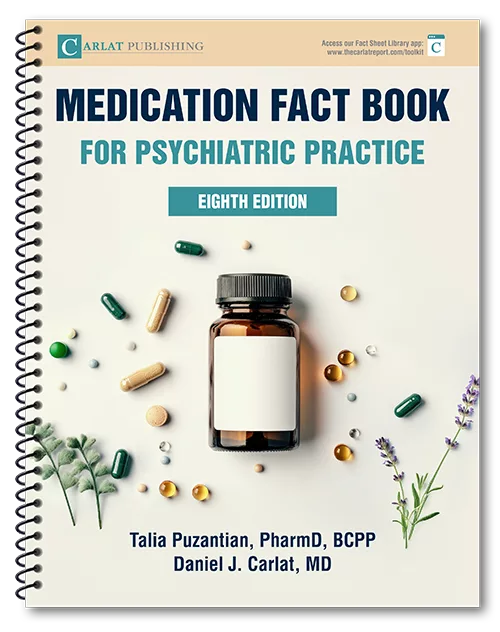Home » Which Are the Most Dangerous Antidepressants?
Which Are the Most Dangerous Antidepressants?
June 1, 2017
From The Carlat Psychiatry Report
Daniel Carlat, MD
Editor-in-chief, The Carlat Psychiatry Report
Dr. Carlat has disclosed that they have no relevant financial or other interests in any commercial companies pertaining to this educational activity.
Review of: Nelson JC and Spyker DA, Am J Psychiatry 2017;174(5):438–450
Study type: Retrospective cohort
We often prescribe antidepressants to patients who are suicidal, and unfortunately, some people use these very medications to try to kill themselves. It’s been known for some time that tricyclic antidepressants are among the most toxic in overdose, so we embraced the SSRIs and later medications in part because they are considered to be safer. But how safe are they? A new study attempts to answer that question.
Methods
Researchers identified all 48 FDA-approved medications likely to be prescribed for depression, and then searched for these drugs in the National Poison Data System, which lists all reports of poisoning in the U.S. There were more than 950,000 poisoning reports involving these medicines from 2000 through 2014.
The hazard level of the drugs was measured in two ways: a morbidity index, which described the proportion of exposures that led to an injury serious enough to require hospitalization (like an ICU admission for cardiac monitoring after a tricyclic ingestion); and a mortality index, which is the proportion of exposures that led to death. The people involved in these events had a mean age of 35.8 years, and 62.8% were female.
Results
This study reports a cornucopia of interesting results, and there’s no way to cover them all in this synopsis. Here are some of the highlights that we found especially clinically relevant.
The two most dangerous drugs of all 48 studied were the tricyclic amitriptyline (morbidity index of 345/1,000 and mortality index of 3.8/1,000) and lithium (325/1,000 and 1.3/1,000).
Not surprisingly, tricyclics and MAOIs as classes had the highest morbidity and mortality rates.
Clomipramine was the safest of all tricyclics and was similarly safe in overdose as drugs like citalopram and mirtazapine.
The “second generation” ADs were generally much safer than tricyclics and MAOIs (these included SSRIs, SNRIs, and others such as bupropion and mirtazapine). Within this group of safer drugs, here were some outliers:
— Bupropion and venlafaxine were ranked #1 and #2 respectively in highest mortality rates among the second-generation ADs; bupropion had the highest morbidity rate.
— Among the SSRIs, citalopram was the most dangerous, and in one comparison, it was four times more likely to be fatal than sertraline and escitalopram.
Among atypical antipsychotics, olanzapine and quetiapine had the highest morbidity rates, with respiratory depression being a particularly common problem with these agents.
TCPR’s Take
Before making wholesale changes in your prescribing habits, you should step back and realize how uncommon these bad events actually are. For example, bupropion, the “most lethal” of the second-generation ADs, led to 47 deaths out of over 62,000 overdoses over 15 years. The chance that one of your patients will OD on bupropion is already very scant, and then, among those rare overdose victims, less than 1 person out of 1,000 will die.
Nonetheless, there are a lot of thought-provoking data points in this paper that might affect our practices. If you’re deciding between amitriptyline and duloxetine for fibromyalgia, go with the much safer duloxetine. Bupropion and venlafaxine are the most likely to be hazardous among the newer ADs—which is unfortunate, since bupropion is on the list of first-line ADs for many clinicians. Citalopram really is more dangerous than its racemic cousin escitalopram, meaning that the FDA warning about citalopram dosing is sounding more reasonable than before.
The bottom line is that you should add these data to the many other factors you consider in deciding which antidepressant to prescribe. And don’t forget the basics, such as limiting refills to a weekly supply in patients at high risk of overdosing.
General PsychiatryStudy type: Retrospective cohort
We often prescribe antidepressants to patients who are suicidal, and unfortunately, some people use these very medications to try to kill themselves. It’s been known for some time that tricyclic antidepressants are among the most toxic in overdose, so we embraced the SSRIs and later medications in part because they are considered to be safer. But how safe are they? A new study attempts to answer that question.
Methods
Researchers identified all 48 FDA-approved medications likely to be prescribed for depression, and then searched for these drugs in the National Poison Data System, which lists all reports of poisoning in the U.S. There were more than 950,000 poisoning reports involving these medicines from 2000 through 2014.
The hazard level of the drugs was measured in two ways: a morbidity index, which described the proportion of exposures that led to an injury serious enough to require hospitalization (like an ICU admission for cardiac monitoring after a tricyclic ingestion); and a mortality index, which is the proportion of exposures that led to death. The people involved in these events had a mean age of 35.8 years, and 62.8% were female.
Results
This study reports a cornucopia of interesting results, and there’s no way to cover them all in this synopsis. Here are some of the highlights that we found especially clinically relevant.
The two most dangerous drugs of all 48 studied were the tricyclic amitriptyline (morbidity index of 345/1,000 and mortality index of 3.8/1,000) and lithium (325/1,000 and 1.3/1,000).
Not surprisingly, tricyclics and MAOIs as classes had the highest morbidity and mortality rates.
Clomipramine was the safest of all tricyclics and was similarly safe in overdose as drugs like citalopram and mirtazapine.
The “second generation” ADs were generally much safer than tricyclics and MAOIs (these included SSRIs, SNRIs, and others such as bupropion and mirtazapine). Within this group of safer drugs, here were some outliers:
— Bupropion and venlafaxine were ranked #1 and #2 respectively in highest mortality rates among the second-generation ADs; bupropion had the highest morbidity rate.
— Among the SSRIs, citalopram was the most dangerous, and in one comparison, it was four times more likely to be fatal than sertraline and escitalopram.
Among atypical antipsychotics, olanzapine and quetiapine had the highest morbidity rates, with respiratory depression being a particularly common problem with these agents.
TCPR’s Take
Before making wholesale changes in your prescribing habits, you should step back and realize how uncommon these bad events actually are. For example, bupropion, the “most lethal” of the second-generation ADs, led to 47 deaths out of over 62,000 overdoses over 15 years. The chance that one of your patients will OD on bupropion is already very scant, and then, among those rare overdose victims, less than 1 person out of 1,000 will die.
Nonetheless, there are a lot of thought-provoking data points in this paper that might affect our practices. If you’re deciding between amitriptyline and duloxetine for fibromyalgia, go with the much safer duloxetine. Bupropion and venlafaxine are the most likely to be hazardous among the newer ADs—which is unfortunate, since bupropion is on the list of first-line ADs for many clinicians. Citalopram really is more dangerous than its racemic cousin escitalopram, meaning that the FDA warning about citalopram dosing is sounding more reasonable than before.
The bottom line is that you should add these data to the many other factors you consider in deciding which antidepressant to prescribe. And don’t forget the basics, such as limiting refills to a weekly supply in patients at high risk of overdosing.

Issue Date: June 1, 2017
Table Of Contents
Recommended
Newsletters
Please see our Terms and Conditions, Privacy Policy, Subscription Agreement, Use of Cookies, and Hardware/Software Requirements to view our website.
© 2025 Carlat Publishing, LLC and Affiliates, All Rights Reserved.


_-The-Breakthrough-Antipsychotic-That-Could-Change-Everything.webp?t=1729528747)



